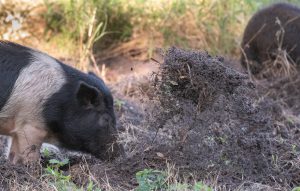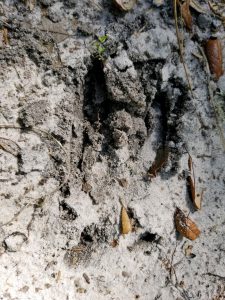Common Name: Wild Pig, Wild Hog, Feral Swine
Status: Invasive Species
Scientific Name: Sus scrofa
Occurrence: Year-round resident throughout Florida
Identification: The average wild pig can be about three foot tall, and over five feet long. Average weight can be 75lbs to over 250lbs. On occasion, wild boars can weigh 400lbs+. Wild pigs come in different colors, due to their ancestry. They can be all black, brown, white & brown, white & black, red, and brindle. Both the males and females have tusks, males typically having the larger tusks.


Description: There are over 500,000 wild pigs by estimation. Second to Texas, which has over 1,000,000 running around in the lone star state. You can find wild pigs most everywhere in Florida. Favorite areas include those near water. Wild pigs do not have sweat glands. This can be pretty rough in Florida, especially in the hot, scorching summer months. They like to be near water so that they can wallow and cool off. A wallow is when they dig out a moist area containing mud or some water. Then they proceed to roll around in it, quite playfully. Near wallows, one might find a “rub” on a tree. By observation, I typically see most rubs on cedars and pine trees. Wild pigs do this to remove the mud, excess hair, and parasites. Of course, I am sure they simply like to itch a scratch on occasion. Breeding can occur most of the year. During one year, a female sow can have up to two litters. Each litter averages six to eight piglets. Maturity happens fast. Females become sexually mature in one year, able to then produce another generation. Life is relatively short for wild pigs. Average lifespan could be 1-2 years, with some sows living up to four years in the wild. Wild pigs have an impressive foraging range. Females have a home range averaging around 370 acres, while males have a larger range of about 740 acres.

Diet: Wild pigs are omnivores. Most of the diet, over 85%, is that of different types of vegetation. Examples include the roots, bulbs, tubers, leaves, and fruit of plants. They will also feed on acorns of various oaks and hickory nuts. Wild pigs are opportunists. They will not pass up an easy meal. Reptiles, amphibians, arthropods, fish, birds, and eggs are all on the menu. Wild pigs have also been known to predate on other mammals such as newborn fawns.
Invasive and Economical Impacts: Wild pigs are an invasive species. They are not native to our state. Wild pigs directly or indirectly cause harm to native flora, fauna, the economy, the environment, and even human health. Wild pig economic damage have been in the billions. They will feed on crops, destroy the terrain, affect water quality, compete with native wildlife, affect livestock, and transmit several serious diseases. Wild pigs carry harmful diseases such as Pseudorabies and swine brucellosis. They are also a host to ectoparasites such as ticks, which also carry diseases that may harm humans.

Interesting Facts:
- Boars have a “Hog Shield” that covers an area roughly around their shoulder and back of neck. This shield, which can be 3/4″ to 1″ thick, helps protect them from the tusks of rival males when fighting.
- Groups of wild pigs are called “Sounders”
- Wild pigs have four tusks that are always growing. These tusks rub against each other, keeping sharp at all times.
- Wild pigs are thought be have been introduced around the 1500’s by the Spanish explorer Hernando DeSoto.
- Males are called boars; females are called sows; and young are called piglets.
- Male raccoons are are also called boars and females sows. Young are called kits!

Cover Photo and Other Photo Credit: Jim E. Davis

Pictures may not be used unless receive written permission from Jim E. Davis. Pictures must be used for educational purposes only.
References: https://edis.ifas.ufl.edu/publication/UW442
https://wildpigs.nri.tamu.edu/about/an-overview-of-wild-pigs/
https://wildlife-damage-management.extension.org/food-habits-of-feral-hogs/
https://edis.ifas.ufl.edu/pdf/FR/FR439/FR439-Dsr1ns611r.pdf
 2
2
